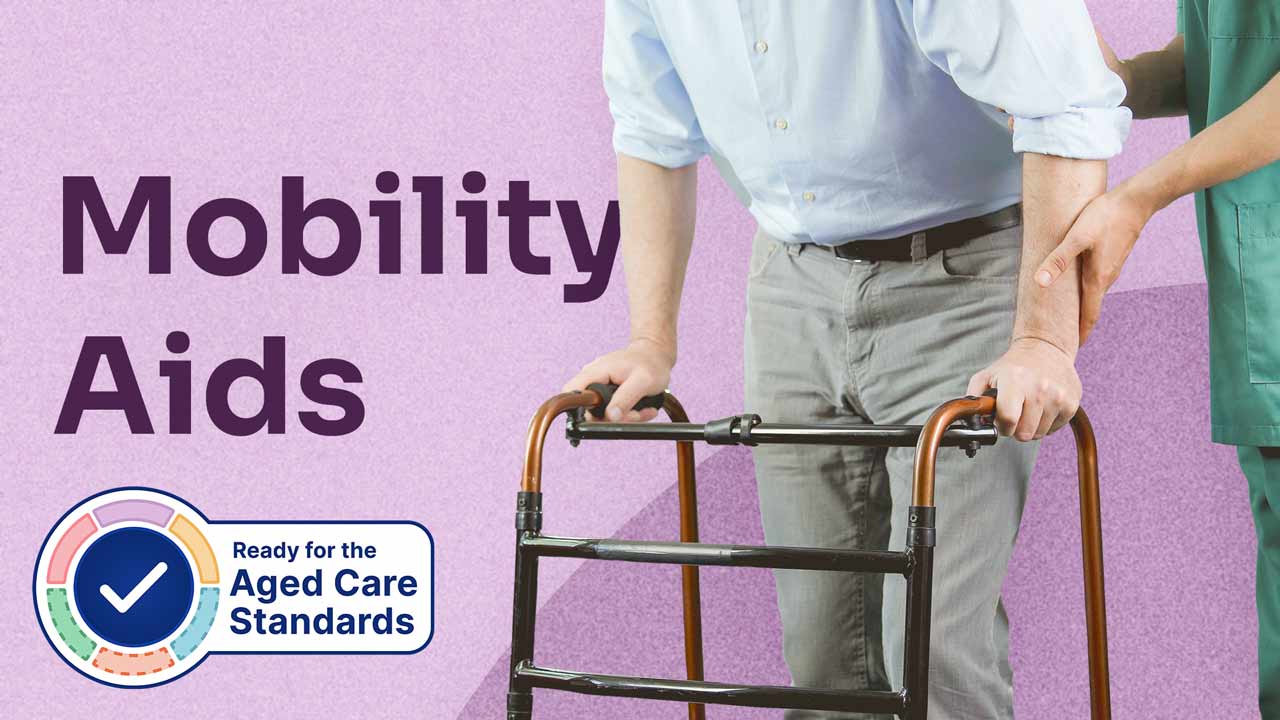About 93% of people living in residential aged care facilities and half of Australians living with disability use mobility aids (ABS 2017).
Therefore, as a healthcare worker, you are likely to interact with clients using mobility aids. Do you know how to appropriately care for these people and ensure they stay safe?
What Are Mobility Aids?
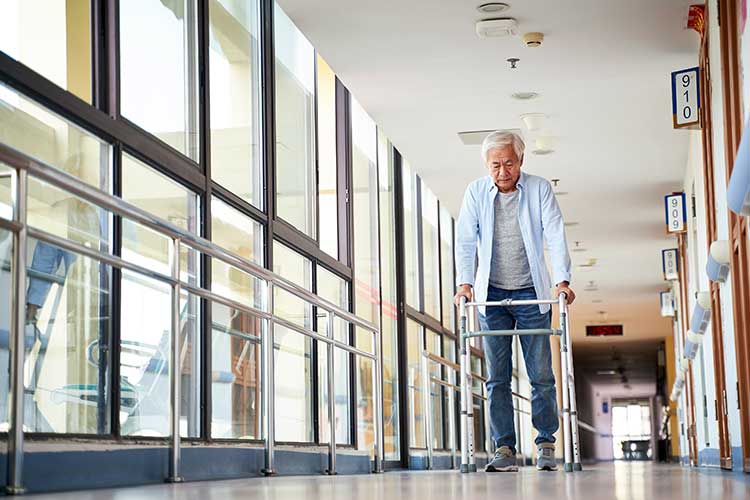
Mobility aids help to improve the functional capacity of people who have difficulty ambulating through one or more of the following:
- Improving balance
- Improving walking pattern
- Increasing propulsion
- Reducing the load on lower limbs
- Transmitting sensory cues through the hands
- Facilitating upright posture
- Allowing the client to access to a variety of environments
- Signalling to other people that the person requires special considerations
- Improving overall safety during independent mobilisation.
(Musculoskeletal Key 2017; Physiopedia 2020)
Benefits of Mobility Aids
- Greater independence
- Ability to go about daily life
- Ability to participate in the community
- Greater quality of life
- Increased confidence and self-esteem
- Reduced pain and fatigue
- Social inclusion
- Improved end-of-life care
- Reduced falls risk
- Reduced risk of hospitalisation
- Shorter hospital stays.
(Better Health Channel 2019; Musculoskeletal Key 2017; CECOPS 2014; Leonard 2017; Independent Living Centre 2019)
Who Uses Mobility Aids?
Mobility aids can be helpful for any person with a mobility issue. This includes, but is not limited to:
- People with:
- Arthritis
- Cerebral palsy
- Diabetic ulcers or wounds
- Balance difficulties
- Fractures or broken bones
- Gout
- Heart or lung issues
- Leg, foot or back injuries
- Sprains or strains
- Brain injury or stroke
- Visual impairment or blindness
- Older adults
- People who have had an amputation
- People who are recovering from surgery
- People with a high falls risk.
(Leonard 2017)
Mobility Aids Under the Strengthened Aged Care Quality Standards
Standard 4: The Environment - Outcome 4.1b: Environment and equipment in a service environment under the strengthened Aged Care Quality Standards (Action 4.1.3b) requires that equipment used in care and services for older people be safe, clean, well-maintained and appropriate for their needs (ACQSC 2024a).
Additionally, Standard 5: Clinical Care - Outcome 5.4: Comprehensive care (Action 5.4.2) expects that aged care providers identify and provide any equipment, aids, devices and products required by an older person as part of comprehensive clinical assessments (ACQSC 2024b).
Outcome 5.5: Clinical Safety (Action 5.5.10) also requires older people with sensory impairment to be given access to and supported to use assistive devices and aids to improve their independence, function and quality of life (ACQSC 2024b).
Types of Mobility Aids
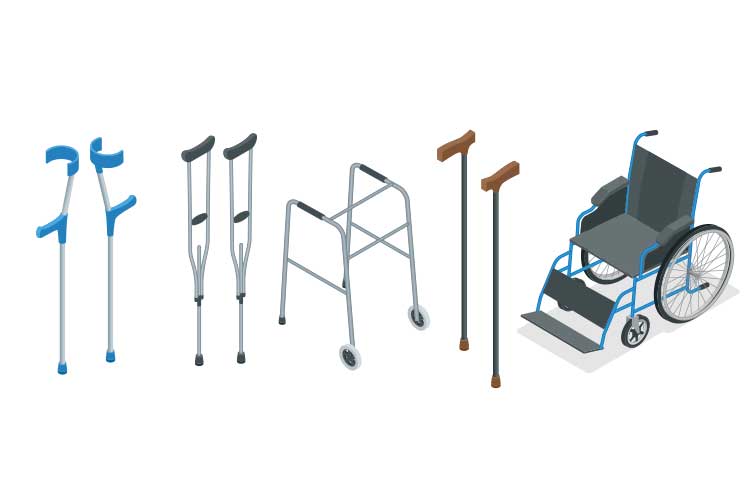
Mobility aids come in a variety of sizes and styles. The person’s abilities, needs, environment and body shape should always be taken into consideration when choosing a mobility aid (Independent Living Centre 2019).
Larger mobility aids are usually more stable but may decrease walking speed and make it more difficult to access certain environments (CEC 2016a).
Generally, a physiotherapist or occupational therapist will be responsible for prescribing a mobility aid (CEC 2016a). This will be based on an assessment of several factors, including:
- Gait
- Balance
- Cognition
- Physiological systems (cardiovascular, musculoskeletal and neurological)
- Comorbidities
- Daily mobility requirements
- Whether the mobility aid is required short term or long term.
(Physiopedia 2020)
The following table lists some of the mobility aids you might encounter when caring for clients:
Crutches, Walking Sticks and Walking Frames
| Mobility Aid | Commonly Used for | Benefits | Limitations |
|---|---|---|---|
| Underarm crutches | Acute, short term injuries where the client can only put weight on one leg |
|
|
| Forearm/elbow crutches | Long term support for clients who can put weight on both legs |
||
Walking sticks/canes
|
|
|
|
| Three and four-wheeled walking frames | People who can walk well but require extra support for long distances |
|
|
| Two-wheeled walking frames (Rollator frames) |
|
||
| Static walking frames | People who require support for standing and walking |
||
| Forearm support frames |
|
Height adjustable |
Lack maneuverability due to larger size |
(Independent Living Centre 2019; National Multiple Sclerosis Society 2013; CEC 2016a, c)
Correctly Fitting Crutches, Walking Sticks and Walking Frames
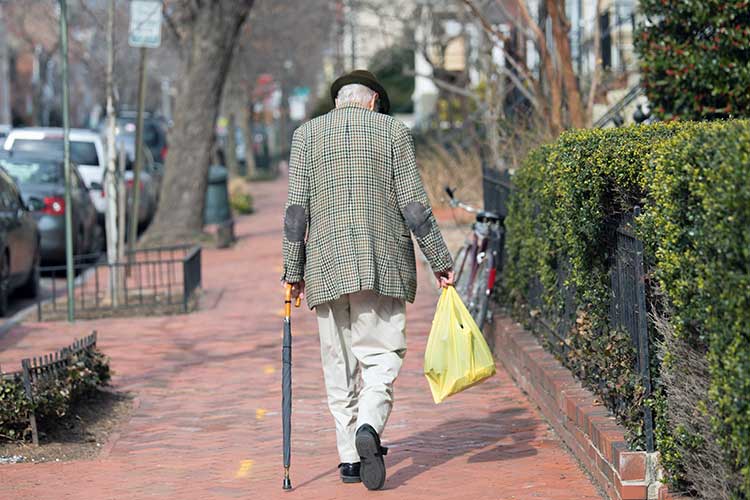
Underarm Crutches
- The top axilla pad should be 5 cm under the armpit
- The base of the crutch should be 15 cm from the foot
- The client's elbows should be at a 15 to 30 degree bend
- The handgrip should be at the height of the wrist crease.
Forearm/elbow Crutches
- The client's elbows should be at a 15 to 30 degree bend
- The handgrip should be at the height of the wrist crease
- The forearm cuff height should be set by measuring from a clenched fist to 2.5 cm below the elbow crease.
Walking sticks/canes
- The client should stand upright with shoulders relaxed and arms by their sides
- The client's elbows should be at a 15 to 30 degree bend
- The handle should be at the height of the wrist crease
- The base of the stick should be 15 cm from the foot.
Walking frames (Three and four-wheeled, two-wheeled and static)
- The client should stand upright with shoulders relaxed and arms by their sides
- The client's elbows should be at a 15 to 30 degree bend
- The handle should be at the height of the wrist crease.
Forearm support frames
- The client's shoulders should be relaxed
- There should be a 90 degree bend at elbow
- The gutters of the frame should rest under the forearm.
(Independent Living Centre 2019; CEC 2016a, c)
Note: Fitting measurements may vary depending on your organisation. Always refer to your organisation's policies and procedures.
Wheelchairs and Scooters
| Mobility Aid | Commonly Used for | Benefits | Limitations |
|---|---|---|---|
| Manual wheelchair | People who are unable to walk functional distances independently, safely or efficiently |
|
|
| Pushrim-activated power-assist wheelchair (PAPAW) | People who have difficulty propelling a manual wheelchair |
|
|
| Power wheelchair | People who have difficulty propelling a manual wheelchair |
|
|
| Motorised scooter | People who have difficulty walking but can sit down and stand up from a chair safely and independently |
|
|
(National Multiple Sclerosis Society 2013)
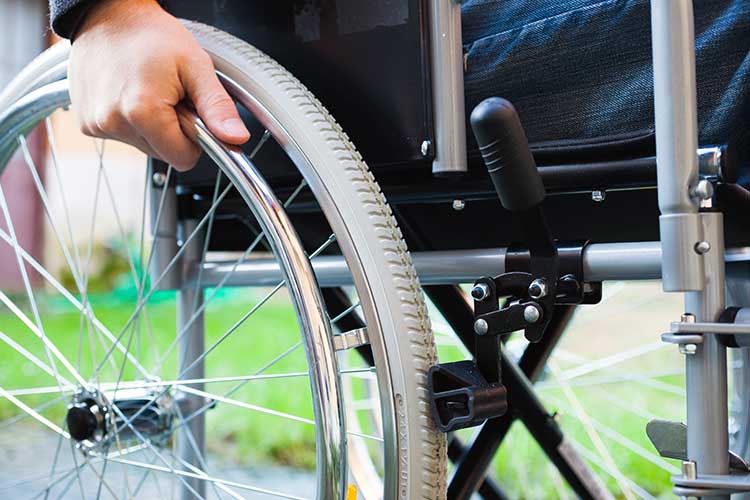
Caring for Clients who use Mobility Aids
The following are some practical tips for ensuring clients who use mobility aids are able to ambulate safely and effectively:
- Check client notes for any instructions about mobilisation.
- Ensure you know the client’s capacity (i.e. whether they can get out of bed on their own, how far they are able to walk, whether they need assistance).
- Always ensure the height and size of the aid are correctly adjusted to suit the client.
- Ensure any tripping hazards such as mats and power cords are cleared from walkways. There should be enough unobstructed space for the client to move around safely using their mobility aid.
- Ensure the client’s bed is a suitable height and the brakes are on.
- Ensure the client’s mobility aid is able to fit through walkways.
- Look out for wet or uneven flooring.
- Ensure the lockable brakes on the mobility aid are engaged properly.
- Check brakes, wheels and rubber tips regularly for damage (protruding or missing screws, split or loose hand grips, worn rubber tips etc.).
- Consider the weight and size of the mobility aid when transporting the client.
- Ensure the client’s footwear is well-fitting, flat and non-slip.
- Ensure the client never uses the mobility aid to pull themselves into a standing position.
- Consider administering pain relief (if required) around the time of mobilisation.
- Refer the client to a physiotherapist if required.
(Independent Living Centre 2019; CEC 2016b, 2017)
Conclusion
In order to ensure the clients in your care are able to ambulate safely, it is important that you understand and are familiar with the various mobility aids they might be using. This will help you to better understand their needs, be able to support them in a range of daily activities and tasks, and appropriately address any hazards or problems they might encounter while using their mobility aid.
Test Your Knowledge
Question 1 of 3
Ross is 82 years old. He can walk fairly well, but requires extra support for longer distances. What type of walking frame would be most appropriate for Ross?
Topics
Further your knowledge
References
- Aged Care Quality and Safety Commission 2024a, Standard 4: The Environment, Australian Government, viewed 22 May 2024, https://www.health.gov.au/resources/publications/strengthened-aged-care-quality-standards-august-2025?language=en/environment
- Aged Care Quality and Safety Commission 2024b, Standard 5: Clinical Care, Australian Government, viewed 22 May 2024, https://www.health.gov.au/resources/publications/strengthened-aged-care-quality-standards-august-2025?language=en/environment
- Australian Bureau of Statistics 2017, Use of Aids and Equipment by People With Disability in Australia, Australian Government, viewed 11 September 2023, https://www.abs.gov.au/ausstats/abs@.nsf/Previousproducts/4430.0Main%20Features952015?opendocument&tabname=Summary&prodno=4430.0&issue=2015&num=&view=
- Better Health Channel 2019, Aids and Equipment at Home, Victoria State Government, viewed 11 September 2023, https://www.betterhealth.vic.gov.au/health/servicesandsupport/aids-and-equipment-at-home
- CECOPS 2014, Benefits of Disability Equipment, CECOPS, viewed 11 September 2023, http://www.cecops.org.uk/about-community-equipment/benefits-of-community-equipment/
- Clinical Excellence Commission 2016b, CEC- Falls Prevention - Safe Use of Mobility Aids – Pickup and Rollator Frames (May 2016), online video, 17 June, viewed 11 September 2023, https://www.youtube.com/watch?v=uYL2lzRWxY0
- Clinical Excellence Commission 2016c, Falls Prevention – Safe Use of Mobility Aids – Forearm Support Frame (May 2016), online video, 17 June, viewed 11 September 2023, https://www.youtube.com/watch?v=ZV01-lwNwng&feature=emb_title
- Clinical Excellence Commission 2016a, Falls Prevention – Safe Use of Mobility Aids – Pickup and Rollator Frames (May 2016), online video, 17 June, viewed 11 September 2023, https://www.youtube.com/watch?time_continue=37&v=uYL2lzRWxY0&feature=emb_title
- Clinical Excellence Commission 2017, Pointers for Safe Mobilisation - Give it a Go!, New South Wales Government, viewed 11 September 2023, http://cec.health.nsw.gov.au/__data/assets/pdf_file/0009/399690/Pointers-For-Safe-Mobilisation-Give-It-A-Go!.pdf
- Independent Living Centre 2019, Walking Aids: Using and Measuring, Government of South Australia, viewed 11 September 2023, https://www.scribd.com/document/508946000/walking-aids-using-and-measuring
- Leonard 2017, ‘What Types of Mobility Aids are Available?’, Medical News Today, 18 July, viewed 11 September 2023, https://www.medicalnewstoday.com/articles/318463
- Musculoskeletal Key 2017, Assistive Devices for Ambulation, Musculoskeletal Key, viewed 11 September 2023, https://musculoskeletalkey.com/assistive-devices-for-ambulation/
- National Multiple Sclerosis Society 2013, How to Choose the Mobility Device That is Right For You, National MS Society, viewed 11 September 2023, https://www.nationalmssociety.org/nationalmssociety/media/msnationalfiles/brochures/brochure-how-to-choose-the-mobility-device-that-is-right-for-you.pdf
- Physiopedia 2020, Walking Aids, Physiopedia, viewed 11 September 2023, https://www.physio-pedia.com/Walking_Aids
 New
New 